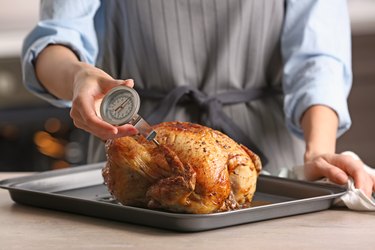
Measuring the internal temperature of cooked turkey ensures the meat has been heated to the point at which it can be eaten safely. Knowing at what temperature to pull turkey from the oven will also ensure the meat will be tender and not overcooked. Both digital and analog thermometers can be used for this purpose, and proper placement will ensure a correct measurement.
Taking the Temperature
Video of the Day
The USDA recommends that turkey be heated to an internal temperature of 165 degrees Fahrenheit for safe eating. To get a proper measurement, place the probe of the thermometer into the center of the thickest part of the breast. If you have reached bone you have pushed too far. It's best to insert the thermometer from the front, so it travels parallel to the bone. With a probe thermometer or a traditional metal meat thermometer, insert the thermometer before roasting. The thermometer's metal probe will conduct heat into the turkey breast, so it's always a good idea to move the thermometer to the other breast to double-check your reading.
If you're using an instant-read thermometer, take the turkey from the oven as it nears the end of its cooking time, and insert the thermometer in the same way. Wait a minute or so until the temperature on the display stabilizes, and then read it. With either type of thermometer, pull your bird from the oven when it reaches the USDA's recommended turkey temperature of 165 degrees. Let it rest for at least 15 minutes before you begin carving. This will raise the internal temperature about another five degrees, which will ensure the entire breast has been cooked thoroughly. It also allows the juices to redistribute throughout the meat making for easier carving and a more tender meal.
Digital or Dial
A variety of thermometers are now available to the home cook. Digital thermometers and probe-type thermometers are popular in home kitchens because they're relatively inexpensive, deliver precise measurements and can be easier to read than the standard metal devices. A convenient feature of many probe-type digital thermometers is that they can be set to sound an alarm when your food has reached the desired temperature.
The standard metal versions that have a dial display work just as well, but without the bells and whistles. One advantage of these thermometers is that you won't run out of battery power right before testing the temperature of the Thanksgiving turkey.
Calibrating the Thermometer
No matter which version you choose, you will want to check its calibration occasionally. You can do this by placing the probe end of the thermometer into a glass of ice and water. The ice bath should measure 32 degrees Fahrenheit or 0 degrees Celsius.
If the measurement is off even slightly, you will need to make an adjustment. Check the manufacturer's guidelines on how to do this with the electric versions. Usually, the simple metal tools can be adjusted manually by adjusting a screw on the back or base of the dial. Don't shirk this part of the process. Meat that is even a couple of degrees undercooked can be dangerous to consume.
Check out this related video from ExpertVillage on Youtube